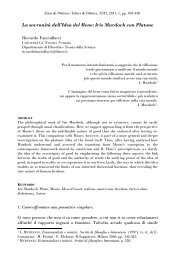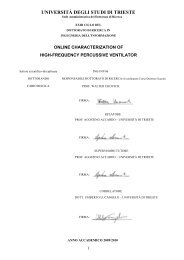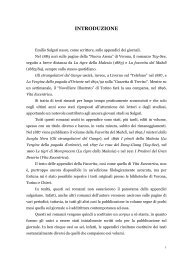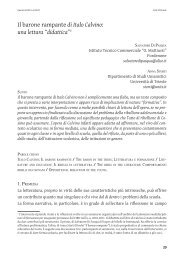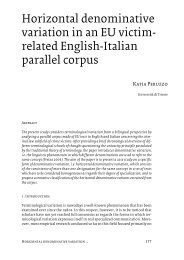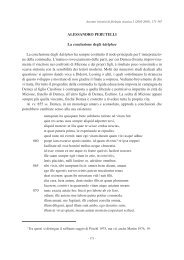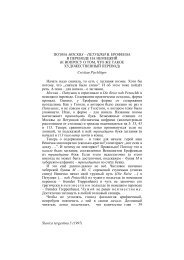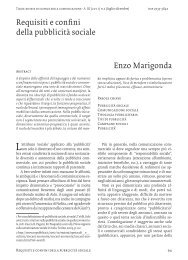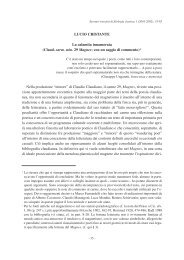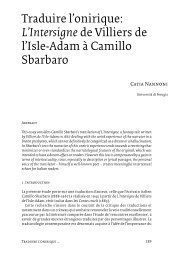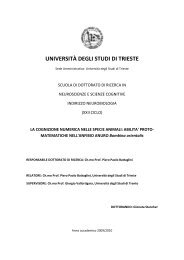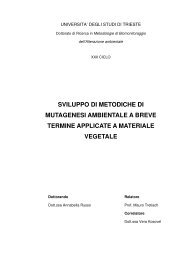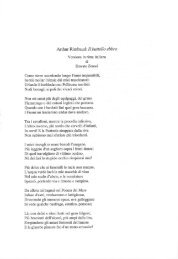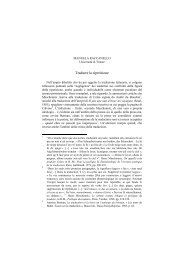tesi dottorato fabbro.pdf - OpenstarTs - Università degli Studi di Trieste
tesi dottorato fabbro.pdf - OpenstarTs - Università degli Studi di Trieste
tesi dottorato fabbro.pdf - OpenstarTs - Università degli Studi di Trieste
You also want an ePaper? Increase the reach of your titles
YUMPU automatically turns print PDFs into web optimized ePapers that Google loves.
3° Giorno<br />
1. Raccogliere il 1° output in 1 ml <strong>di</strong> 2xYT. Aggiungere glicerolo sterile fino alla<br />
concentrazione max 20%. Conservare a -80°C.<br />
2. Ripetere i passaggi del 1° Giorno partendo da un inoculo del 1° output.<br />
COATING: saturare un immunotubo con l’antigene (htTG) 10 µg/ml <strong>di</strong>luito in 500 µl - 1<br />
ml <strong>di</strong> PBS 1X e lasciare O/N a 4°C.<br />
4° Giorno<br />
Procedere come il 2° Giorno ma aumentando la stringenza:<br />
1. Incubare in rotazione per 30' e fermo 1h 30' a T ambiente.<br />
2. Svuotare l’immunotubo e fare 10 lavaggi con PBS 1X - Tween 0.1% e 10 con PBS<br />
1X.<br />
3. Aggiungere 2 ml <strong>di</strong> PBS 1X - Tween 0.1% e lasciare in rotazione per 30' a T<br />
ambiente.<br />
4. Svuotare l’immunotubo e fare 5 lavaggi con PBS 1X - Tween 0.1% e 5 con PBS<br />
1X.<br />
5. Svuotare l’immunotubo e mettere 500 µl - 1 ml <strong>di</strong> DH5αF' a DO600 = 0.5.<br />
6. Lasciare infettare per 45' a 37°C.<br />
7. Piastrare su piastre 2xYT + Amp 1% + glucosio 1%: 200 µl <strong>di</strong> DH5αF' per<br />
controllare l’assenza <strong>di</strong> contaminazioni; 500 µl - 1 ml delle cellule DH5αF'<br />
infettate coi fagi (2° output); una <strong>di</strong>luizione per calcolare la titolazione della 2°<br />
selezione.<br />
8. Far crescere le piastre O/N a 37°C.<br />
5° Giorno<br />
1. Preparare una master plate in una piastra da microtitolazione da 96 pozzetti<br />
mettendo in ciascuno 120 µl <strong>di</strong> 2xYT + Amp 1% + glucosio 1% + 1 colonia<br />
piccata dalla piastra della 2° selezione.<br />
2. Far crescere in agitazione a 37°C.<br />
64



